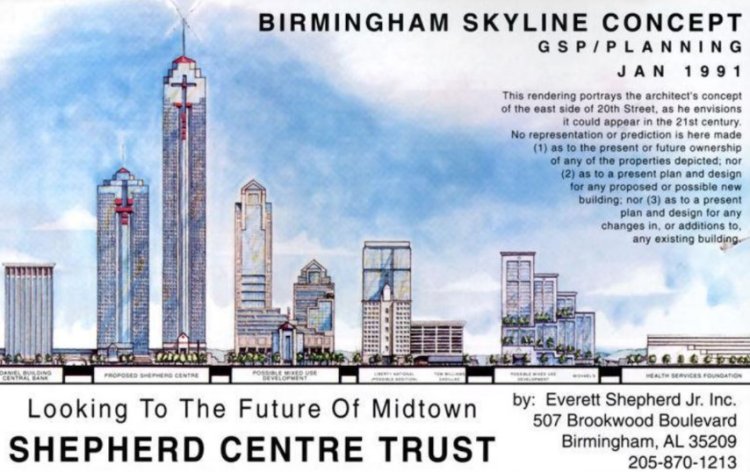How Birmingham’s Skyline Could Have Transformed with a $200 Million 1980s Project
Thirty-seven years ago, a Birmingham developer unveiled an ambitious vision for the Magic City’s 21st-century skyline.

Thirty-seven years ago, a Birmingham developer unveiled an ambitious vision for the Magic City’s 21st-century skyline.
The Shepherd Centre proposal included a 68-story office tower between First and Second Avenues South and a 42-story tower near 20th and 21st Streets, with an estimated cost of up to $200 million.
A recent Reddit post revived interest in the project, prompting questions about its fate. Newspaper accounts from the time reveal that the proposal was bold, even during an era when downtown Birmingham saw frequent new skyscraper developments.
Had they been built, the Shepherd Centre structures would have surpassed Birmingham’s tallest current building, the 454-foot Shipt Tower, which was only a year old when the proposal was made. The main building would have been among the tallest in the South, excluding several in Texas.
The Shepherd Centre was proposed in 1987 by Everett Shepherd Jr., the developer behind Brookwood Village and other local projects. It represented a pre-telecommuting era and would have dwarfed anything in downtown Birmingham at the time.
David Fleming, CEO of REV Birmingham, praised Shepherd’s vision. "I remember it well," he said. "It's great that he had such confidence in, and vision for, downtown Birmingham. But there never was a market for that much office space at that time."
Designed by Michael Waldheim of Gresham, Smith and Partners, the buildings would have included roughly 2 million square feet of office space, plus retail and residential areas. To put that in perspective, that’s a third of Birmingham’s current Central Business District space.
Shepherd proposed the project without securing an anchor tenant, though he suggested it could house the Kirklin Clinic and State Farm. However, the clinic preferred a site closer to UAB, and State Farm chose its headquarters. Shepherd passed away in 1997.
As late as 1991, Shepherd proposed several high-rise buildings along 20th Street South, promoting the "future of Midtown." But even then, companies were moving to suburban office parks, and downtown already had excess space.
The Shepherd Centre was envisioned during a time when corporations sought large-scale downtown offices. Economic changes, including mergers, acquisitions, and the 2000 recession, ultimately doomed the project.
Fleming noted that a project of that magnitude would have required a large corporate commitment, likely larger than any existing in Birmingham at the time. Had the buildings been constructed, Birmingham might face an even larger surplus of downtown office space today.
According to Cushman & Wakefield, the Birmingham metro area had an office vacancy rate of 15.7% in the first quarter of 2024. The central business district's rate was 14.3%, while Midtown recorded a 7.2% rate. Despite these figures, Birmingham fares better than many other U.S. cities, including Atlanta, Houston, Portland, Los Angeles, and Chicago, all of which have vacancy rates of 25% or higher.







